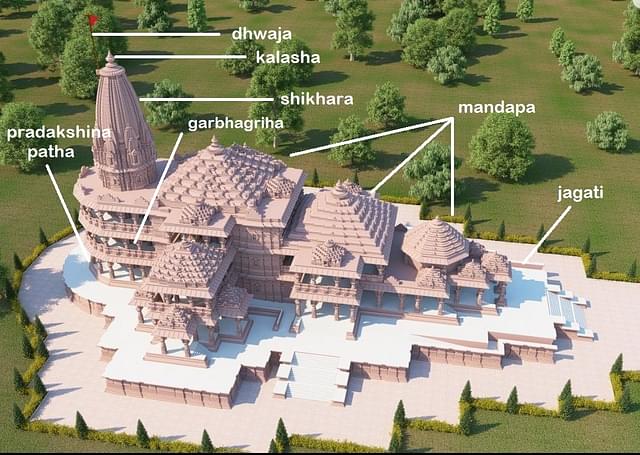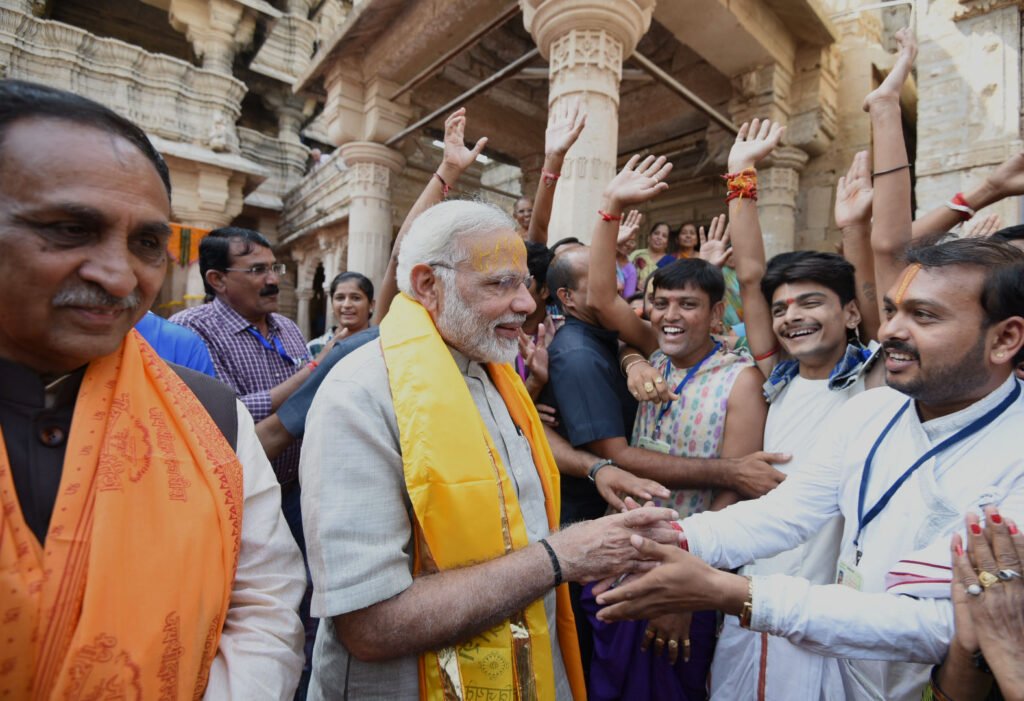The story of Shri Ram Mandir Ayodhya is inspired by the Ramayana, a major epic of Hinduism. The temple was built at the place where Lord Rama was born, and his revered image is enshrined there. Rich in mythological elements and cultural significance, this narrative has played a significant role in shaping the beliefs and sentiments of millions of Hindus over the centuries.

The construction of the temple was a historic moment, in which the entire community and social organizations contributed. This can be seen as the beginning of a new era, symbolizing the strong carrying forward of Hindu religion and cultural heritage.
Historical Timelines of Ram Mandir Ayodhya
1528-1529: Mughal Emperor Babur initiated the construction of Babri Masjid.
1850: Communal violence erupted over land disputes.
1949: An idol of Lord Rama was found inside the mosque, intensifying communal tensions.
1950: Two cases were filed in Faizabad Civil Court seeking permission for idol worship.
1961: Uttar Pradesh Sunni Central Waqf Board demanded the removal of the idol.
1986: District court opened the site for Hindu worshippers.
1992: On December 6th, Babri Masjid was demolished.
2010: Allahabad High Court ordered the disputed area to be divided among Sunni Waqf Board, Nirmohi Akhara, and the deity Ramlalla.
2011: The Supreme Court upheld the Allahabad High Court’s decision.
2016: Subramanian Swamy filed a plea in the Supreme Court, demanding the construction of the Ram Temple.
2019: The Supreme Court acknowledged Ayodhya as Lord Rama’s birthplace, awarded the entire disputed 2.77 acres to the trust and directed the government to allocate 5 acres as an alternative site to the Sunni Waqf Board.
2020: Prime Minister Modi performed the groundbreaking ceremony and laid the foundation stone.

Architecture Design of Ram Mandir Ayodhya
The Ram Mandir Ayodhya is a magnificent blend of historical heritage and carefully crafted design. Established by the visionary Somapura family in 1988, the temple’s design was developed in 2020, inspired by Hindu scriptures. It is planned to be the world’s third-largest Hindu temple, with dimensions of 235 feet in width, 360 feet in length, and 161 feet in height.
The main attractions of the architectural marvel include Nagara-style mandaps and 366 pillars representing various deities. Extending beyond the main temple, the complex, outlined by Larsen & Toubro, offers a comprehensive experience to over 70,000 visitors. In essence, the Ram Temple is a cultural and spiritual marvel, symbolizing India’s rich heritage.
The temple’s dedication and meticulously crafted design play a crucial role in portraying India’s prosperity and historical legacy, resonating with a sense of prosperity and unity for those who experience it.
Why Ram Mandir is So Popular
A devoted follower named Satya Prakash Sharma has crafted a special lock weighing 400 kilograms for the vigilance of the deity Ram Lalla, ensuring the security of the Ram Temple. The lock is 10 feet long, 4.6 feet wide, and 9.5 inches thick. This handcrafted lock is currently the world’s largest, symbolizing the dedication and craftsmanship of the devotee towards safeguarding the sacred site.
The entire temple, being constructed on a 70-acre land, will have three floors, and each floor will be 20 feet high. Within the temple complex, there will be temples dedicated to Sage Valmiki, Sage Vashishtha, Sage Vishwamitra, Sage Agastya, Nishad Raj, Mother Shabari, and Goddess Ahilya.
Approximately 70% of the 70-acre temple complex area will be lush green, adorned with trees that are more than a hundred years old.
| Total area | 2.7 Acres |
| Total built-up area | 57,400 Sq.feet |
| Total length of the temple | 360 feet |
| Total width of the temple | 235 feet |
| Total height of temple (including peak) | 161 feet |
| Total floors | 3 |
| Height of each floor | 20 feet |
| No. of columns in ground floor | 160 |
| No. of columns in first floor | 132 |
| No. of columns in second floor | 72 |
| No. of pavilions | 5 |
| No. of gates in the temple | 12 |
The sacred precinct of Lord Rama’s birthplace spans across 70 acres, encompassing various segments of mythological significance. The primary temple complex comprises five pavilions, each designated for specific purposes, namely Nritya (Dance), Color, Sabha (Assembly), Prayer, and Kirtan (Devotional Song) Pavilions. Additionally, the sacred premises are further divided into distinct areas, each holding its own spiritual and historical significance.

Modern Facilities/Amenities in Ram Temple Premises
Multipurpose Distribution and Operations Room
Bank/ATM
Essential Public Utilities (Toilets, Bathroom, Washroom & More)
Emergency Medical Facilities
Ramps/Lifts for Senior Citizens
Solar Energy Panels and Power Back-Ups
Pilgrim facility center
Pilgrim/Visitor Management System
How to Reach Ram Mandir Ayodhya
1. From Delhi:
By Air: Approx. 500 km, 1.5 hours flight + additional travel to Ayodhya.(₹3,000 to ₹10,000 (one way).)
By Train: Approx. 800 km, 7-9 hours by train.(₹500 to ₹2,000 (one way).)
2. From Mumbai:
By Air: Approx. 1300 km, 2.5-3 hours flight + additional travel to Ayodhya.
Price – ₹4,000 to ₹15,000 (one way).
By Train: Approx. 1500 km, 24-30 hours by train.
Price – Approx. ₹1,000 to ₹3,000 (one way).
3. From Kolkata:
By Air: Approx. 900 km, 2 hours flight + additional travel to Ayodhya.
Price – ₹5,000 to ₹12,000 (one way).
By Train: Approx. 1300 km, 20-25 hours by train.
Price – ₹1,500 to ₹3,500 (one way).
4. From Chennai:
By Air: Approx. 1600 km, 3-4 hours flight + additional travel to Ayodhya.
Price – ₹6,000 to ₹15,000 (one way).
By Train: Approx. 1800 km, 30-35 hours by train.
Price – ₹2,000 to ₹4,500 (one way).
5. From Bangalore:
By Air: Approx. 1400 km, 2.5-3 hours flight + additional travel to Ayodhya.
Price – ₹5,000 to ₹14,000 (one way).
By Train: Approx. 1700 km, 30-35 hours by train.
Price – ₹2,500 to ₹5,000 (one way).
6. From Hyderabad:
By Air: Approx. 800 km, 2 hours flight + additional travel to Ayodhya.
Price – ₹4,000 to ₹10,000 (one way).
By Train: Approx. 1000 km, 20-25 hours by train.
Price – ₹2,000 to ₹4,000 (one way).
7. From Ahmedabad:
By Air: Approx. 1200 km, 2 hours flight + additional travel to Ayodhya.
Price – ₹4,000 to ₹12,000 (one way).
By Train: Approx. 1400 km, 22-28 hours by train.
Price – ₹1,500 to ₹3,500 (one way).
These are rough estimates and actual prices may vary. It’s advisable to check current prices and availability before planning your trip.
Note – Uttar Pradesh State Road Transport Corporation (UPSRTC) operates regular buses from Lucknow to Ayodhya. The journey takes approximately 4-5 hours.
Best Time to Visit Ram Mandir
Winter (October to March):
- Ideal for Ayodhya visits with pleasant weather during festivals like Diwali and Dussehra.
- Construction of the grand Ram Temple is underway, adding to its religious significance.
- Key attractions include Hanuman Garhi, Nageshwarnath Temple, Kanak Bhawan, Dasharatha Bhawan, and Mani Parbat.
- Suitable for pilgrims and history enthusiasts, but hotel prices may rise.
Summer (April to June):
- High temperatures, reaching up to 48 degrees Celsius.
- Pilgrims continue to visit for darshan and worship of Lord Ram.
- Longer daytime allows for extensive exploration.
- Hotel tariffs are comparatively lower, making it a preferred season for budget travelers.
Monsoon (July to September):
- Known as ‘Chaturmaas’ in religious scriptures.
- Pleasant climate but hampers extensive sightseeing due to incessant downpours and floods in major rivers.
- Considered less favorable for a comprehensive exploration of Ayodhya.
Each season offers a unique experience, catering to different preferences and priorities of visitors.
Things To Explore Near Ram Mandir
1.Hanuman Garhi
Climb the 76 stairs to reach this ancient temple dedicated to Lord Hanuman, offering panoramic views of Ayodhya.
2. Nageshwarnath Temple
Pay a visit to this temple built by Lord Rama’s son Kush, dedicated to Lord Shiva, especially vibrant during Shivaratri and other Shiva Pujas.
3.Kanak Bhawan
Admire the ‘house of gold’ featuring gold-crowned idols of Lord Rama and Sita, with religious and historical significance.
4. Dasharatha Bhawan
Explore the grand palace where Lord Rama’s father, King Dasaratha, resided, showcasing intricate decorations.
5. Mani Parbat
Experience the religious and mythological significance of this site, believed to be connected to the search for Sanjivani Booti by Hanuman.
6.Dashashwamedh Ghat
Relax by the Saryu River and partake in rituals or take a boat ride to enjoy the serene surroundings.
7.Ayodhya Art Gallery
Explore the rich cultural heritage of Ayodhya through traditional art and artifacts.
8. Sita Ki Rasoi
Visit the kitchen believed to be used by Sita, offering a glimpse into ancient traditions and mythology.
9. Attend Festivals
Plan your visit during festivals like Diwali, Dussehra, Ram Navami, or Hanuman Jayanti to witness vibrant celebrations.
10.Local Cuisine Exploration
Try local delicacies and savor the flavors of Ayodhya’s traditional cuisine.
11. Buddhist Stupas and Monasteries
Explore the historical remnants of Buddhist influence, including stupas and monasteries built by Emperor Ashoka.
12. Ayodhya Sant Tulsidas Ghat
Stroll along the ghats, offering a peaceful ambiance and a chance to connect with the spiritual side of Ayodhya.
13. Participate in Aarti
Attend the evening aarti ceremonies at various temples for a spiritual experience.
14. Ayodhya Museum
Learn about the city’s rich history and cultural heritage through artifacts and exhibits in the local museum
Ram Mandir Inauguration and Guest List
The eagerly awaited and momentous occasion for Hindu communities is approaching as the holy inauguration of the Ram Mandir is scheduled for January 22, 2024. Prime Minister Narendra Modi has announced the celebration of the Pran Pratishtha ceremony on this significant day. Notably, both PM Modi and Uttar Pradesh Chief Minister Yogi Adityanath have curated an invitation list for the opening and consecration ceremony of the Shree Ram Mandir.

The Ram Janmabhoomi Trust has extended invitations to approximately 7000 individuals, comprising 3000 VVIPs and 4000 revered seers, for the historic inauguration ceremony. Distinguished attendees from diverse fields, such as politicians, all four Shankaracharyas representing the principal Hindu monasteries, celebrities, cricketers, priests, and other esteemed religious leaders, are anticipated to grace the momentous occasion.
Celebrate Guest List who were invited for Ram Mandir Inauguration
- Amitabh Bachchan
- Madhuri Dixit
- Anupam Kher
- Akshay Kumar
- Rajinikanth
- Sanjay Leela Bhansali
- Chiranjeevi
- Mohanlal
- Dhanush
- Rishab Shetty
- Madhur Bhandarkar
- Ranbir Kapoor
- Alia Bhatt
- Ajay Devgn
- Sunny Deol
- Prabhas and Yash have been sent invites.
- Tiger Shroff
- Ayushmann Khurrana
- Arun Govil
- Deepika Chikhalia Topiwala
- Mukesh Ambani and Anil Ambani
- Gautam Adani and Ratan Tata have been invited.
- Sachin Tendulkar and Virat Kohli

